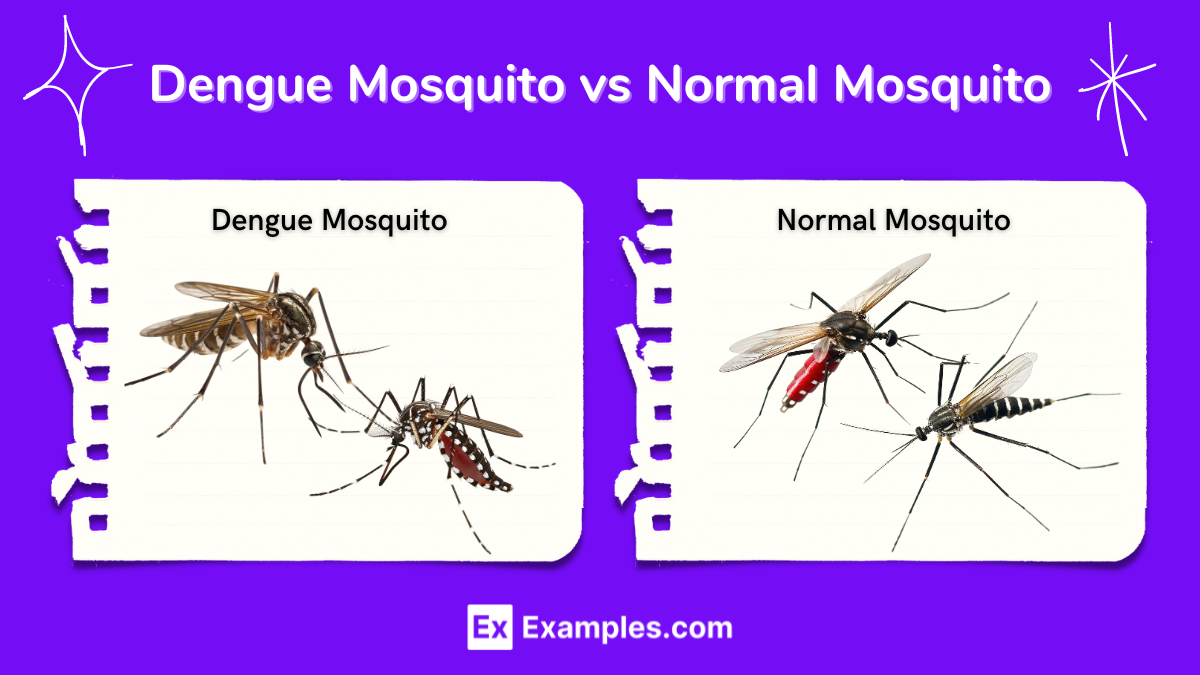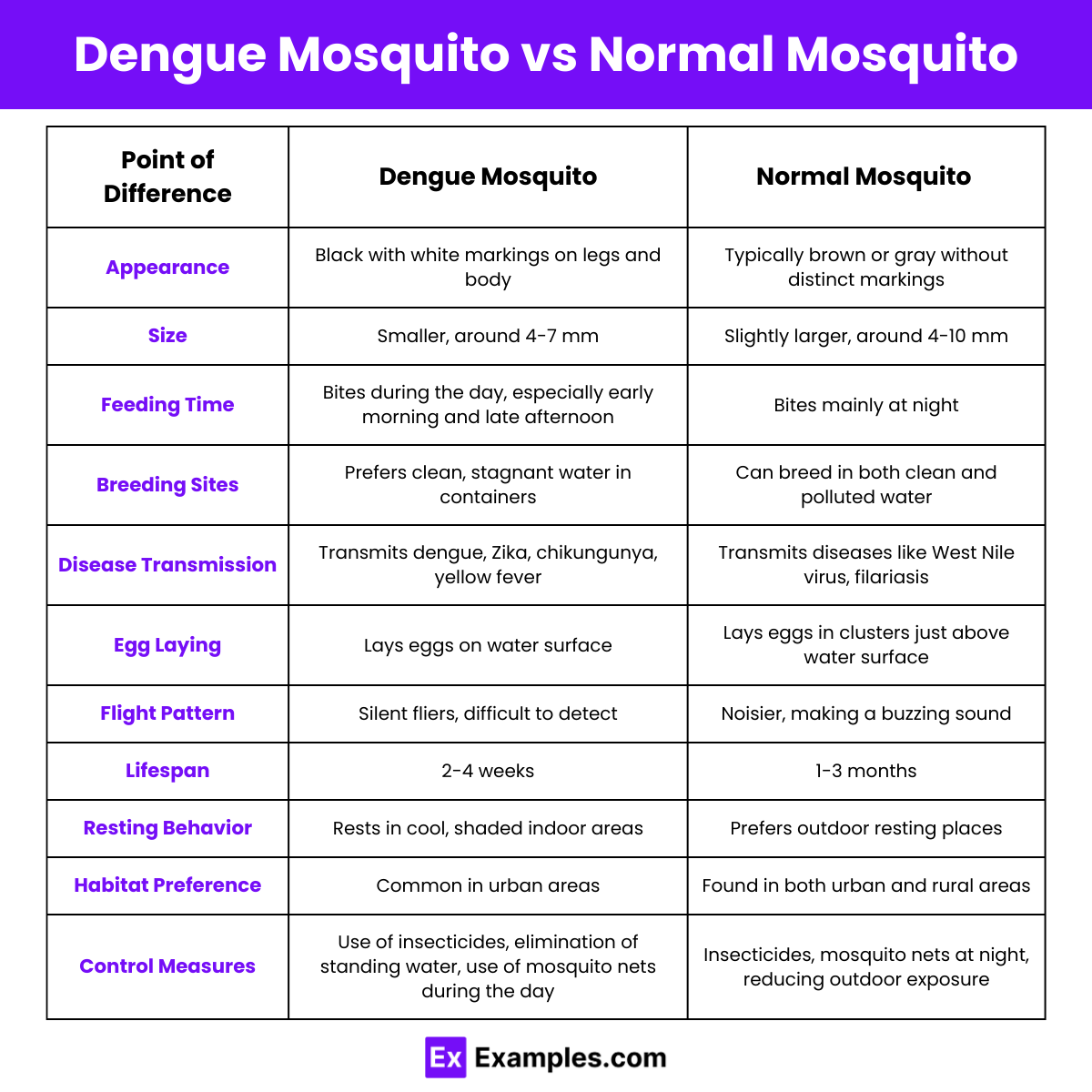What is the primary species of mosquito responsible for transmitting dengue fever?
Anopheles mosquito
Culex mosquito
Aedes mosquito
Mansonia mosquito


Understanding the difference between a dengue mosquito and a normal mosquito is crucial for effective prevention and control of mosquito-borne diseases. Dengue mosquitoes, specifically Aedes aegypti and Aedes albopictus, spread the dengue virus, which can cause severe illness in humans. Normal mosquitoes, while still a nuisance, do not typically carry diseases as harmful as dengue. In this article, we will compare the characteristics, habitats, and behaviors of dengue mosquitoes and normal mosquitoes, highlighting the key distinctions that set them apart.
A dengue mosquito refers to specific species of mosquitoes that transmit the dengue virus. The primary carriers are Aedes aegypti and Aedes albopictus. These mosquitoes are responsible for spreading dengue fever, a viral infection that causes flu-like symptoms and can lead to severe health complications.
A normal mosquito refers to common mosquito species that do not typically transmit the dengue virus. These include species like Culex pipiens and Anopheles gambiae, which may spread other diseases but are not primary carriers of dengue. Understanding the differences between normal mosquitoes and dengue mosquitoes helps in effective mosquito control and disease prevention.

| Feature | Dengue Mosquito (Aedes aegypti and Aedes albopictus) | Normal Mosquito (Culex pipiens and Anopheles gambiae) |
|---|---|---|
| Appearance | Black and white markings; lyre-shaped pattern on thorax (Aedes aegypti) | Varies; Culex is brown with lighter bands; Anopheles is dark and speckled |
| Activity Period | Daytime, especially early morning and late afternoon | Evening and nighttime |
| Feeding Habits | Prefers human blood for egg production | Feeds on both human and animal blood |
| Breeding Sites | Clean stagnant water in containers (e.g., flower pots, tires) | Various water sources, including polluted water and marshes |
| Primary Diseases Transmitted | Dengue fever, Zika virus, chikungunya, yellow fever | West Nile virus (Culex), malaria (Anopheles), St. Louis encephalitis |
| Geographic Range | Tropical and subtropical regions | Worldwide, in both tropical and temperate regions |
| Environmental Preferences | Urban areas with available standing water | Varied habitats, including rural and urban areas |
| Prevention Measures | Remove stagnant water, use repellents, wear protective clothing | Eliminate standing water, use insect repellents, install mosquito nets |
| Vector Control | Community-wide initiatives, public education, vector control programs | Surveillance, larviciding, community education programs |
| Egg Laying Behavior | Lays eggs on damp surfaces just above waterline, eggs can survive dry conditions for months | Lays eggs directly on the surface of water |
| Flight Range | Short flight range, typically within 200 meters of breeding site | Longer flight range, can travel several kilometers |
| Lifespan | Generally 2-4 weeks, depending on environmental conditions | Varies; Culex can live several weeks to months, Anopheles about 2 weeks |
| Larval Habitat | Prefers clean, stagnant water found in man-made containers | Prefers a wide range of water bodies, including polluted and natural waters |
| Resting Habits | Often rests indoors, in dark, cool places such as closets and under furniture | Rest outdoors in vegetation or other sheltered areas |
| Behavior Towards Humans | Highly anthropophilic (prefers humans over animals) | Less anthropophilic, feeds on both humans and animals |
| Flight and Feeding Style | Quiet and stealthy, often unnoticed during feeding | Noisier, more likely to be noticed during feeding |
| Resistance to Insecticides | Some populations show resistance to common insecticides | Varies, but resistance can develop in some populations |
Mosquitoes are a diverse group of insects that share several characteristics, regardless of the species. Here are the key similarities between dengue mosquitoes (Aedes aegypti and Aedes albopictus) and normal mosquitoes (such as Culex and Anopheles species):
Dengue mosquitoes (Aedes) transmit dengue virus, while normal mosquitoes (like Culex and Anopheles) can transmit other diseases such as West Nile virus and malaria.
Dengue mosquitoes have white markings on their legs and a lyre-shaped pattern on their thorax, distinguishing them from other mosquitoes.
Dengue mosquitoes breed in standing water found in containers, tires, plant saucers, and other places with stagnant water.
Dengue mosquitoes are most active during the early morning and late afternoon, unlike some normal mosquitoes active mainly at dusk and dawn.
No, only Aedes mosquitoes (dengue mosquitoes) can transmit dengue fever. Normal mosquitoes do not carry the dengue virus.
Normal mosquitoes, like Culex and Anopheles, can transmit diseases such as West Nile virus, malaria, and Zika virus.
Yes, female mosquitoes of both dengue and normal species require blood meals to develop their eggs. Males feed on nectar.
Prevent mosquito bites by using insect repellent, wearing long sleeves, and eliminating standing water where mosquitoes breed.
Dengue mosquitoes are a concern because they spread dengue fever, a potentially severe viral illness affecting millions globally.
Yes, mosquito control measures like eliminating standing water, using repellents, and installing screens are effective against both dengue and normal mosquitoes.
Text prompt
Add Tone
10 Examples of Public speaking
20 Examples of Gas lighting
What is the primary species of mosquito responsible for transmitting dengue fever?
Anopheles mosquito
Culex mosquito
Aedes mosquito
Mansonia mosquito
How can you visually differentiate an Aedes mosquito from a normal mosquito like Culex?
Aedes mosquitoes have white markings on their legs
Culex mosquitoes have black and white stripes on their abdomen
Aedes mosquitoes have a brown body color
Culex mosquitoes have a white spot on their head
Which mosquito species is known to bite during the day?
Anopheles mosquito
Culex mosquito
Aedes mosquito
Mansonia mosquito
Which type of mosquito is more likely to be found breeding in urban areas?
Anopheles mosquito
Culex mosquito
Aedes mosquito
Mansonia mosquito
What is a common symptom of dengue fever caused by Aedes mosquitoes?
Persistent cough
Severe abdominal pain
Itchy rash
Mild headache
Which mosquito species is more commonly associated with malaria transmission?
Aedes mosquito
Culex mosquito
Anopheles mosquito
Mansonia mosquito
How do Aedes mosquitoes typically lay their eggs compared to Culex mosquitoes?
Aedes mosquitoes lay eggs in containers with stagnant water
Culex mosquitoes lay eggs in moving water
Aedes mosquitoes lay eggs on vegetation near water
Culex mosquitoes lay eggs on the surface of large lakes
Which mosquito species is more likely to be active at night?
Aedes mosquito
Culex mosquito
Anopheles mosquito
Mansonia mosquito
What is one preventive measure to reduce Aedes mosquito breeding?
Installing air conditioners
Removing standing water from around homes
Using mosquito nets only at night
Applying insect repellent to pets
Which mosquito species is less likely to be involved in transmitting diseases?
Aedes mosquito
Culex mosquito
Anopheles mosquito
Mansonia mosquito
Before you leave, take our quick quiz to enhance your learning!

